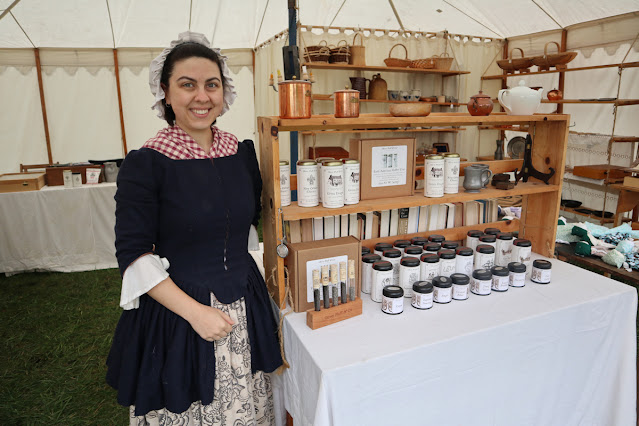The meteorologists lied to us once again. Up through the night before they predicted sunny skies with temps in the mid-60s, as they've been saying all week, for the day I was to attend Bay City's River of Time. But---nope!---we awakened Saturday morning to an overcast sky, and had showers nearly the entire two-hour drive north to this small Michigan city. And once we arrived we had another downpour. However, by 11 a.m. the rain subsided and pretty much remained that way for the rest of the time I was there. Clouds were a constant, however.
Over the years I've heard a lot of good things about Bay City's River of Time timeline event, but I've not been to it before. This year was my first time attending...and participating. Timeline events seem to be growing in popularity of late, especially as doing a mock battle becomes more difficult (hint---why we need more younger people participating!!). However, Bay City's River of Time has been going on for thirty years, so they were a forerunner of the gamut. At least in this area. I consider it an honor to be asked to take part in such a longstanding tradition such as this.
Upon walking the grounds, I was impressed with the amount of reenactors there - tents could be seen stretched out for hundreds of yards...and then some...that was great to see.
This tells me that contrary to popular belief, reenacting is alive and well.
 |
| One part of the area for reenactors. The tents stretched beyond the trees. |
The way it has been for the most part this year has been that the reenacting numbers have been down. Well, if they were down at Bay City, it sure wasn't noticeable to me! And there was a strong visitor count as well - even with the cool damp weather. And I do believe numbers will rise even higher within the next couple of years; after two and a half years of fear being instilled into people's brains, it may take a bit of time to expel it and get them to come out.
But, yeah...I'll say it again: reenacting is alive and well.
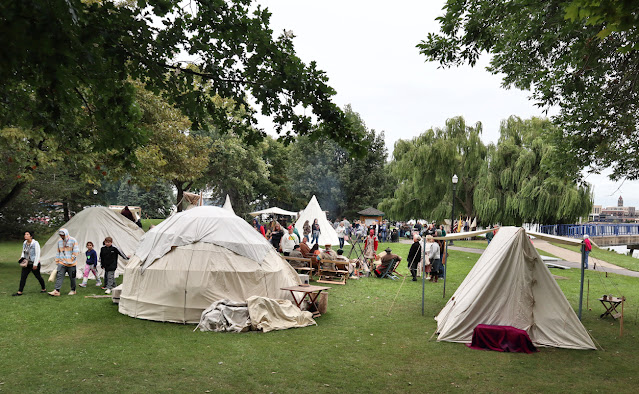 |
| Another area for the reenactors to camp in. And there were other sections I did not capture the images of. |
 |
| Hey! Hey! Look who is listed first on the program! I truly am honored. |
It was early this past spring that I was asked to do my portrayal of Paul Revere for this event, and I readily accepted. Paul Revere has been my patriot hero since I was a child and I have not had many opportunities to portray him of late - it's been since March that I had - so, yeah, here was a chance to bring him to life again and to tell the truth of his story. My only real concern was I hoped I would not be too rusty, since it's been a while. Judging by the response I received from the audience after my engagement had ended - and the personal comments I received from a few folk as I roamed about the event afterward - my concerns dissipated.
They liked it!
Shortly before my speech I was asked by a patron if I get nervous speaking in front of an audience. My answer was a resounding "no" for I have been in front of audiences most of my adult life, either playing my guitar, taking part in the Holly Dickens Festival, which really played a role in over-coming shyness (if I had any in the first place), then reenacting - you can't be shy if you reenact for there are always people watching you, photographing you, and asking you questions - and then performing with my Simply Dickens vocal group.
Even as a child I liked to sort of perform by singing Beatles' songs constantly in front of people with my pretend mic (a stick or a brush) and air guitar (before anyone knew what an air guitar was, by the way), or even on one of the toy plastic guitars I would receive here and there before I got my first "real" guitar.
Ain't no room for shyness in my life!
 |
| I stood upon the deck/porch of an 1860s cabin for my presentation. |
 |
| Two lanterns were "shewn" in the steeple of the Old North Church |
It is an honor for me to portray Paul Revere. This early patriot did more than most people realize - too many still believe the myths and rumors and, in more recent times, condemnations without taking the time to search for themselves for the truth (isn't that the way it is these days?) - and I like to believe Mr. Revere himself is happy with what I'm doing.
I also work on de-Longfellow-izing him, that is, pointing out that the Poem written in his honor, Paul Revere's Ride, was far from the truth:
As is stated on the Paul Revere Heritage Project website, “(Longfellow) meant to retell the story taking the liberty to dramatize Revere’s individuality, patriotism and the fight for independence. Longfellow created a national icon from a local folk hero hardly known outside Massachusetts. He also dramatized Revere’s ride creating a national myth.
During (the last half) of the nineteenth century Longfellow’s poem was considered a historical account and evidence of what happened the night of April 18, 1775 and many textbooks were written based on Longfellow’s poem. During the 20th century, textbook writers and historians tried to portray a more objective account of the facts. They argued about the inaccuracies of the poet’s account and what were the real events, they tried to demythologize the poem.
Nevertheless, Longfellow's poem has become so successful and ingrained in every American mind that readers no longer remember it as a poem but as a national legend. It is a reminder of the patriotism that led to independence and a part of the American culture."
 |
| No, I did not ride through the countryside yelling, "The British are coming!" |
Patriotism is a wonderful thing, so I can appreciate that. But let's find the patriotism in truth rather than myths. That's my goal. Paul Revere was a great man who did wonderful things and deservedly belongs in his place in American History, to be sure, but he was not a god nor a man without fault.
To read a concise piece on Revere that covers the truth of what happened on the night of April 18th, 1775, please click HERE.
One of the things I really got a kick out of while here in Bay City, where I know very few people (even in the reenacting world in this area), was when people wanted my attention they did not yell out to me "Hey Ken!" Rather, aside from a very few folk I was only known as Paul Revere or, as most would say, "Mr. Revere."
That was kind of cool.
My friend and fellow patriot Ben Franklin (aka Bob Stark) was there, too, and he and his daughter had their sutlery set up to sell some very cool history-oriented items to any interested patron.
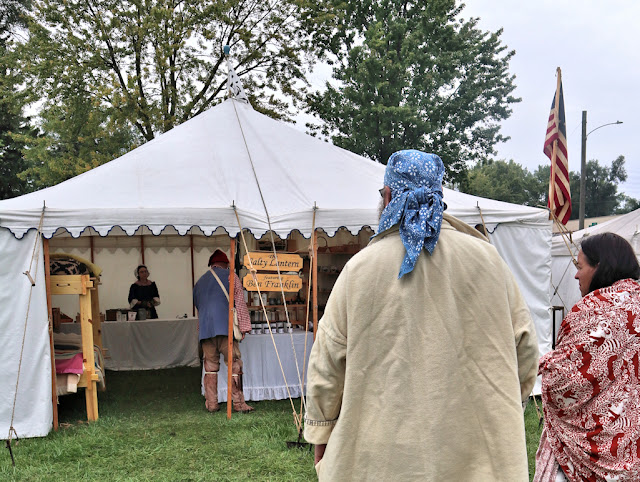 |
| Ben Franklin's Salty Lantern |
 |
Ah...all is well and good between us, dear madam. You may have your tea. |
 |
| This group is so good! The Tittabawassee Fife and Drum Corps performed in front of the cabin immediately following my presentation, which made for the perfect interlude and connection between myself and the man who came after me: |
 |
| Bob does the original Franklin proud, and I believe the two men had very similar personalities. |
Being that River of Time is a timeline event, showing not only military but civilian and frontier life as well, I also have other photos of a few of the reenacting groups that took part:
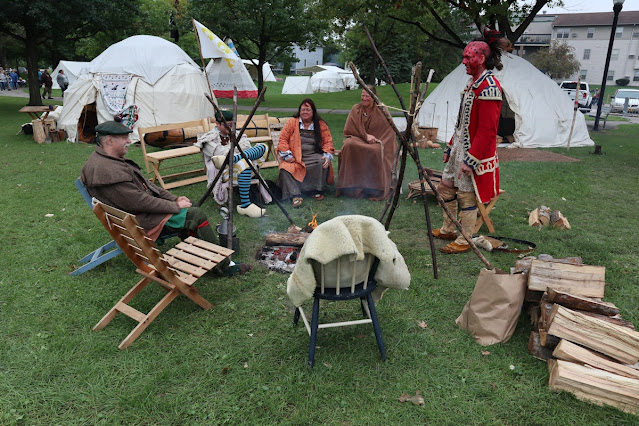 |
| We see Voyageurs intermingling with the local Indian tribes. |
The Voyageurs befriended, learned from and intermarried with the local Indians who were already here when they arrived. They built earthen huts and farmed "strip farms," bought, sold, and traded animal fur and pelts, and adapted the Indian-style canoes to move about the waterways.
 |
| Explaining daily life living utensils of the 18th century. Such a great teaching moment for the kids sitting up front as well as the adults standing behind. |
Pre-Revolution French & Indian War era was well-represented at Bay City.
The French and Indian War was the North American conflict in a larger imperial war between Great Britain and France known as the Seven Years' War. The war provided Great Britain enormous territorial gains in North America, but disputes over subsequent frontier policy and paying the war's expenses
(re: the Stamp Act of 1765) led to colonial discontent, and ultimately to the American Revolution.
I think it would have been cool to see a sort of Andrews Sisters group for the WWII section, perhaps a hippie-type folk singing protester with the Viet Nam group, and other music to help enhance other periods.
 |
| The heavy overcast of clouds gave for interesting photo opportunities as these soldiers and civilian of the French & Indian War walk along the river... |
 |
| ...and posed for me. |
There were plenty of us representing civilians of the Revolutionary War.
In her modern life she raises sheep, shears them, and then prepares the wool for spinning on her spinning wheel. Susan will then dye the wool utilizing various methods, both period and modern.
Wait---did I say "in her modern life" ??
At her Carrot Patch Farm sutlery, one can purchase wool, homespun yarn, or even items she makes such as hats, socks, and mittens.
Top-notch quality all the way!
 |
| Tittabawassee Fife and Drum Corps I must say, hearing the sounds of the fife & drum was...um...music to my ears. No, really! I've spoken often of eight, sound, smell, touch, and taste - the five senses - playing a major role in our transport to the past at events, and the musical sounds of groups such as the Tittabawassee Fife and Drum Corps simply enhances the entire event! |
Just something to think about.
 |
| Also in the colonial section of the park were a couple of blacksmiths, including this one here. |
 |
| I really like displays such as this, where everything is displayed on blankets and folks can ask about the items soldiers would have had during the time of America's Civil War. |
 |
| Civil War soldiers doing firing demonstrations. |
The Union army had more than 70 volunteer Zouave regiments throughout the conflict, while the Confederates fielded about 25 Zouave companies.
 |
| Have you ever had a chicken cooked this way? If not, once you do, you'll not want to go back to the more conventional way. So good! |
 |
| The return echo coming from across the Saginaw River from the cannon firing was very cool. |
We then take a leap up to World War II.
It very much surprised me with the low turn-out of WWII reenactors, considering it is the hottest era going in the reenacting world today.
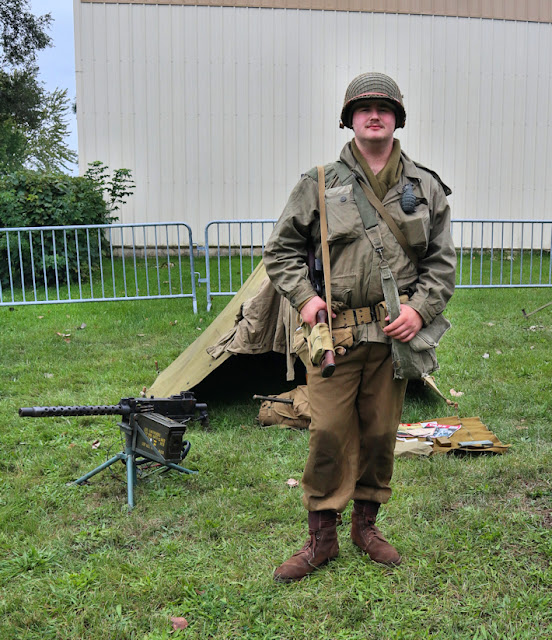 |
| I'm thinking next year we'll see more of all eras in this timeline, including WWII |
Now we'll head into the 1960s.
'Tis true that I did not take many pictures of the later wars - my fault. There just seemed to be so much going on that I was bouncing around different eras minute by minute. Plus I have some fairly close friends in the older eras that I don't see as often as I'd like to, so I spent extra time with them.
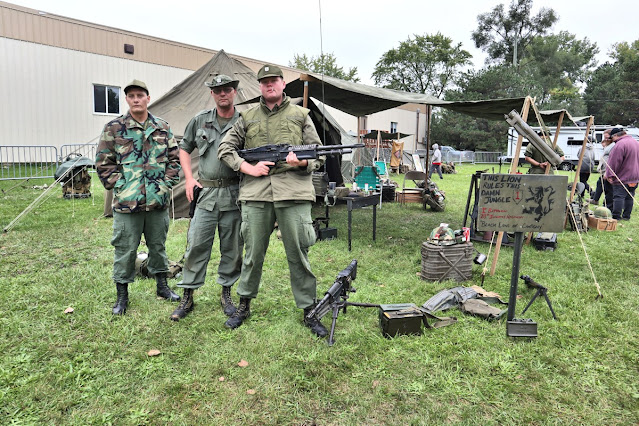 |
| Viet Nam was camped next to the WWII camp. |
 |
| I wonder if their sign was based upon an actual sign. |
Next year I'll make sure to get more photos of the later eras.
Living history timelines such as Bay City's River of Time are such amazing events to see the past come to life - to see progression from over a few centuries - culminating to the modern visitor. As the program states (and I fully agree):
Reenactors have the best knowledge and abilities for our historical presentations, and our volunteers are able to support our event with their hard work and dedication to event logistics. Reenactors find our first-person impressionists and help put together the programs for our education tent in addition to doing their own reenacting.
However, there is one line in the program that makes me particularly happy:
See you next year! September 22, 23, & 24, 2023~
See you next year! September 22, 23, & 24, 2023~
Until next time, see you in time.
To see a Port Sanilac and Chesterfield timeline event, please click HERE
~ ~ ~
